 |
|


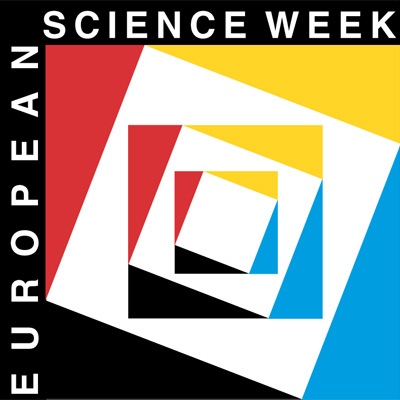

The Venus
Transit 2004
... Photos by Themes
Venus' Aureole
Quite a few observers of the Venus Transit remarked upon a rare
optical phenomenon which could be perceived at the moment of the
second and third contacts. However, unlike the infamous "Black Drop" effect, "Venus'
Aureole" could only be seen under very good observing conditions
and with excellent telescopes. It was described as a "ring of light"
along the perimeter of Venus' black disc and extending beyond the
solar limb. Some observers talked about "Venus' horns", stretching
outwards from the two points where Venus' disc intersected that of the
Sun.
This aureole was first described by the famous Russian natural
scientist Mikhail
Vasil'evich Lomonosov (1711 - 1765) in his "Apparition of
Venus on the Sun, as observed from the Imperial Saint-Petersburg
Academy of Sciences on May 26th, 1761". He correctly interpreted the
phenomenon as the refraction of the sunlight in an atmosphere
surrounding Venus and considered this as additional support of his
conviction that there are many other inhabitable worlds beyond the
Earth.
A fictive observer on the Moon would see the same phenomenon - an
"Earth Aureole" - when the Earth's disc progressively covers the Sun
at the time of a lunar eclipse. It is exactly for this reason that the
Moon appears very red during a total lunar eclipse: the only sunlight
that reaches the Moon when it is entirely inside the Earth's shadow is
that passing through the Earth's atmosphere which "removes" most of
the blue light.
The VT-2004 Photo Archive contains a good
number of photos, both from professional and amateur telescopes, that
show the aureole phenomenon at the beginning and at the end of the
Venus Transit. Some of these photos have been collected on this
thematic page.
Other photos and videos on which Venus' Aureole is well visible are
available at the websites of the Dutch Open Telescope
(DOT) and the Swedish
1-m Solar Telescope (SST), both located on the Canary Islands
(Spain).
All photos on this page may be downloaded and used, provided the
photographers (authors) and the VT-2004 programme are indicated as
source.
 |
|
|
Venus' Aureole at the Second
Contact
|
|
 |
|
|
|
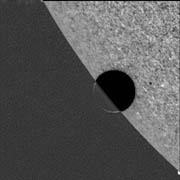
TRACE Image of Venus Transit (Ingress)
[512 x 513 pix
- 184k]
TRACE
[The complete Venus transit was observed from the NASA "Transition
Region and Coronal Explorer (TRACE)" mission in white light.
Images and movies are available here.]
June 8, 2004, 05:27:27 UT
Orbiting Spacecraft
|
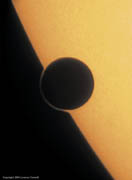
Venus' Ring of Light at Ingress
[561 x 764 pix
- 59k]
Lorenzo Comolli
[Gruppo
Astronomico Tradatese]
20-cm Schmnidt Cassegrain telescope
Panasonic NV-DS15 ditigal comcorder
[Image processing from two videos - one correctly
and another over-exposed]
More images at this
site
June 8, 2004, 05:34 UT
Tradate, Italy
|
|
|
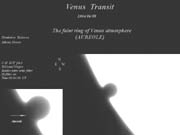
Venus' Faint Ring
[800 x 600 pix
- 121k]
Dmitrios Kolovos
Celestron-11 SCT with Baader Astro-Solar filter
Sony F-717 still digital camera
June 8, 2004, 05:34:30 UT
Athens, Greece
|
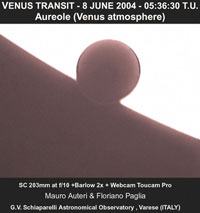
Aureole Effect
[556 x 591 pix
- 54k]
Mauro Auteri & Floriano Paglia
G.V. Schiaparelli Astronomical Observatory, Varese, Italy
SC 203mmm at f/10 + Barlow 2x+ Webcam Toucam Pro.
June 8, 2004 ; 05:36:30 UT
|
|
 |
|
|
Venus' Aureole at the Third
Contact
|
|
 |
|
|
|
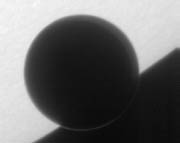
Venus Transit - The End
[648 x 514 pix
- 27k]
DOT Group
45-cm Dutch Open Telescope
G-band image
[Venus' atmosphere is visible as a bright, circular band
outside the solar disc. This remarkable effect is due to
refraction in the upper layers of Venus' atmosphere that
bends the transmitted sunlight in our direction. See also the DOT Egress
movie]
More information at this site.
June 8, 2004
La Palma, Spain
|
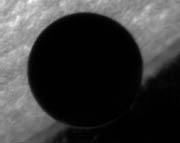
Venus Transit - The End
[648 x 514 pix
- 21k]
DOT Group
45-cm Dutch Open Telescope
Ca II K image
[Venus' atmosphere is visible as a bright, circular band
outside the solar disc. This remarkable effect is due to
refraction in the upper layers of Venus' atmosphere that
bends the transmitted sunlight in our direction. See also the DOT Egress
movie]
More information at this site.
June 8, 2004
La Palma, Spain
|
|
|
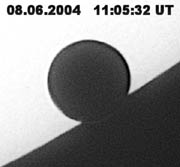
The Atmosphere of Venus
[420 x 390 pix
- 37k]
VT-2004 Team
Slovak Union of Amateur Astronomers
Observatory Rimavska Subota
160/2450mm refractor with AstroSolar filter
CCD camera SHT
June 8, 2004, 11:05:32 UT
Rimavska Subota, Slovakia
More images at this
site
|
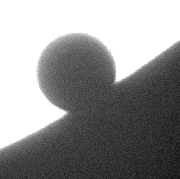
Third Contact - Animation
[Animated GIF -
430 x 428 pix
- 1020k]
VT-2004 Team
Slovak Union of Amateur Astronomers
Observatory Rimavska Subota
160/2450mm refractor
Logitech Quickcam Pro4000 with 2x teleconverter
CCD camera SHT
Combination of 9 exposures, each 0.035 sec
June 8, 2004, mid time 11:06 UT
Rimavska Subota, Slovakia
|
|
|
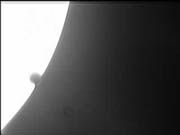
Venus with Atmospheric Ring at Third Contact
[320 x 240 - 4k ]
Robert Stekelenburg
140/2000mm Orion Optics Maksutov OMC140
Philips ToUCam 740k
[Composite of 100 frames from 10sec video;
processed with Astrostack]
June 8, 2004, 11:08 UT
Enschede, The Netherlands
|
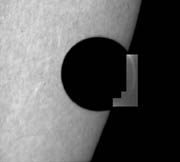
Venus' Atmospheric Ring
[979 x 882 pix
- 66k]
Observatoire de Paris
Meudon Solar Tower
60-cm aperture; 45-m focal length
Monochromatic light (Wavelength 430 nm; bandwidth 10 nm)
June 8, 2004, 11:07:46 UT
Meudon, Paris, France
|
|
|
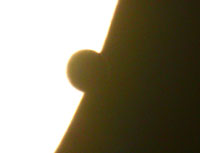
Aurora around Venus
[1255 x 959 pix
- 339k]
Gian Nicola Cabizza
130 mm apocromatic refractor
with Herschel prism.
[During the end of transit, a
dull aurora is visible in the outer edge of Venus]
June 8, 2004
Italy
|
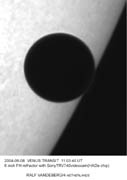
"Ring of Light" - Sharpest Image
[572 x 810 pix
- 71k]
Ralf Vandebergh
6-inch refractor f/8
Sony TRV740 camcorder
June 8, 2004, 11:03:40 UT
The Netherlands
|
|
|

"Ring of Light" in Late Stadium
[1300 x 440 pix
- 76k]
Ralf Vandebergh
6-inch refractor f/8
Sony TRV740 camcorder
June 8, 2004, 11:05 - 11:17 UT
The Netherlands
|
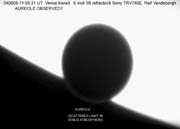
Venus' Atmosphere
[1000 x 802 pix
- 53k]
Ralf Vandebergh
6-inch f/8 refractor
[Sunlight scattered in the upper layers of Venus'
atmosphere produces a bright ring - an "aureole"]
June 8, 2004, 11:05:31 UT
The Netherlands
|
|
|
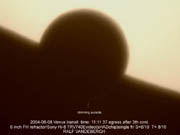
"Ring of Light" in Very Late Stadium
[1000 x 750 pix
- 103k]
Ralf Vandebergh
6-inch refractor f/8
Sony TRV740 camcorder
June 8, 2004, 11:11:37 UT
The Netherlands
|
|
|
|
 |
|
|
[VT-2004 Photo Archive
Top Page]
|
|
|


